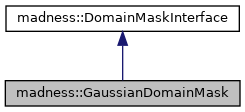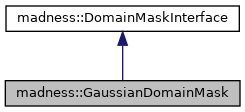Use a Gaussian for the surface function and the corresponding erf for the domain mask. More...
#include <sdf_domainmask.h>


Public Member Functions | |
| GaussianDomainMask (double epsilon) | |
| Constructor for the domain mask. | |
| virtual | ~GaussianDomainMask () |
| double | dmask (double d) const |
| Derivative of characteristic function with respect to the normal distance. | |
| double | dsurface (double d) const |
| Value of d(surface)/ddistance. | |
| double | mask (double d) const |
| Value of characteristic function at normal distance d from the surface. | |
| double | surface (double d) const |
| Value of surface function at distance d normal to surface. | |
 Public Member Functions inherited from madness::DomainMaskInterface Public Member Functions inherited from madness::DomainMaskInterface | |
| virtual | ~DomainMaskInterface () |
Protected Attributes | |
| const double | epsilon |
| The width of the transition region. | |
Private Member Functions | |
| GaussianDomainMask () | |
| Forbidden. | |
Detailed Description
Use a Gaussian for the surface function and the corresponding erf for the domain mask.
Constructor & Destructor Documentation
◆ GaussianDomainMask() [1/2]
|
inlineprivate |
Forbidden.
◆ GaussianDomainMask() [2/2]
|
inline |
Constructor for the domain mask.
- Parameters
-
[in] epsilon The effective width of the surface
◆ ~GaussianDomainMask()
|
inlinevirtual |
Member Function Documentation
◆ dmask()
Derivative of characteristic function with respect to the normal distance.
- Parameters
-
[in] d The signed distance
- Returns
- The derivative
Implements madness::DomainMaskInterface.
References d, epsilon, madness::nonlinear_vector_solver(), and madness::constants::pi.
◆ dsurface()
Value of d(surface)/ddistance.
- Parameters
-
[in] d The signed distance
- Returns
- The derivative of the surface function
Implements madness::DomainMaskInterface.
References d, epsilon, madness::nonlinear_vector_solver(), and madness::constants::pi.
◆ mask()
Value of characteristic function at normal distance d from the surface.
- Parameters
-
[in] d The signed distance. Negative is inside,'' positive isoutside.''
- Returns
- The domain mask
Implements madness::DomainMaskInterface.
References d, epsilon, and madness::nonlinear_vector_solver().
◆ surface()
Value of surface function at distance d normal to surface.
- Parameters
-
[in] d The signed distance
- Returns
- The value of the surface function
Implements madness::DomainMaskInterface.
References d, epsilon, madness::nonlinear_vector_solver(), and madness::constants::pi.
Member Data Documentation
◆ epsilon
|
protected |
The width of the transition region.
Referenced by dmask(), dsurface(), mask(), and surface().
The documentation for this class was generated from the following file: